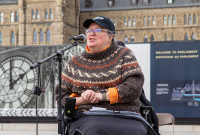Thank you for helping us meet our fundraising goal!
Accessibility has become an increasingly prominent topic over the last few years.
It is one of the leading issues in community design, and cities, provinces and organizations tout their accessibility strategies as evidence of their commitments to inclusion.
But despite this attention, there are still several areas where accessibility gaps are overlooked, two of which I discuss below.
On the surface, these deficits affect people very differently, but common to each is that continuing to neglect them will lead to a host of consequences felt beyond those immediately impacted.
Dangerously unprepared
In recent years, wildfires ended lives in northern B.C. and Alberta, flooding led to deaths in Nova Scotia, Quebec and B.C., and heat waves killed hundreds across Western Canada — where the threat of a major earthquake also looms large.
While climate-related disasters are increasing worldwide, the costs are not distributed equally.
How communities prepare for, respond to and cope with crises reflects who and what they value.
And people who are already marginalized face additional challenges in disaster situations, with emergency management planning and operations showing limited regard for their needs.
Take people with disabilities.
They experience four times the fatality rate and greater exclusion during recovery periods, while evacuation rates among households with a disabled family member are up to 25 per cent lower due to inaccessible transportation and lack of accessible shelters. Deaf and blind persons are also among the least likely to evacuate due to a lack of accessible warning messages.
With emergency services being developed for short-sighted conceptions of an “average” person, it is not only disabled people who suffer.
LGBTQ+ persons face discrimination in the provision of emergency services such as health care and shelter, newcomers with language barriers miss critical warnings, while pregnant women and seniors experience many of the barriers plaguing persons with disabilities.
And look at the effects: 91 per cent of those who died during the B.C. heat waves had a chronic medical condition or a disability, while similar numbers are found when looking at disasters and humanitarian emergencies globally.
Although medically vulnerable populations may always be among the most at risk in these situations, there is no need for the loss of life to be as great as it has.
Years of research highlight structured inequalities in the distribution of vulnerability, capacity, and outcomes, yet many provinces and cities have been slow to adapt and members of disadvantaged communities continue bearing the brunt.
While fatal heat waves of 2021 brought new attention to the issue, it has been cyclical as disasters pass and Canada remains dangerously unprepared — meaning the need to close this accessibility gap is pressing as ever.
Paying the price
The impacts of poverty are devastating and well-documented, but less discussed are the barriers people face in actually being able to access and use their money.
The Canadian Standards Association standardized automated banking machines and self-service interactive devices in 2009 but at present, there are no standards to ensure they are all accessible.
One can still find ATMs that are too high for people using mobility devices or that lack the space for them to fit the front of their device and still reach the keypad.
There continues to be self-checkout and payment machines without audio instructions, headphone jacks or braille for users with limited vision.
And the lack of uniformity between devices also means people with intellectual disabilities or those with lower technological literacy — such as seniors — are disadvantaged, having to relearn each time they use a new machine.
Indeed, evidence shows these populations are slower and make more errors while using financial machines and applications, feel less comfortable using them, are far less likely to use them and have more limited access to them compared to the general population.
Training on these devices is shown to make a difference, but the problems are not restricted to technological know-how.
Even when completed using paper, the steps many persons with disabilities, seniors and low-income persons must go through to access and maintain their financial supports are notoriously lengthy, convoluted, energy-sapping and intrusive — sometimes being intentionally designed as such to deny and reduce applications.
They often require copious amounts of documentation that low-income groups in particular struggle accessing, and the rules around what someone can or cannot do, can or cannot have while receiving benefits can be so confusing that even the people tasked with interpreting these policies are unsure.
For people with disabilities or seniors on fixed incomes, benefits already fall well below the poverty line, but the added barriers they face push them even further away from financial independence, contributing to a less inclusive, economically vibrant and sustainable society.
One to address all?
There are various measures to help close these gaps.
To name just a few: accessibility committees can be formed specifically to inform emergency response strategies, and training with payment machines and banking applications can be offered for target populations.
To ensure a broad impact, it is also critical to establish standards that create greater consistency in accessibility from place to place, while having powerful mechanisms to enforce them — unfortunately, too many pieces of accessibility legislation do not.
Ultimately, to get to the root of the problem, accessibility and inclusion must become embedded in our thinking and how we look at public issues, which requires sustained education efforts and a refusal to accept the status quo.
Only when that happens will they become embedded into the approaches that follow. This will take much longer than a year to achieve, so we might as well get to it.
Spencer van Vloten is a nationally published writer and community advocate from Vancouver. He is a recipient of the BC Medal of Good Citizenship, Vancouver Excellence Award, and was named the Rick Hansen Foundation Difference Maker of the Year.
You can find more of his work at SpencerV.ca or follow him on X at @SpencerVanCity






Comments